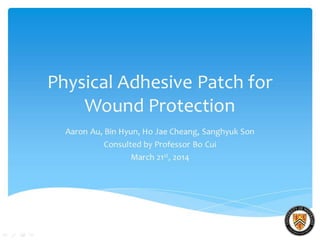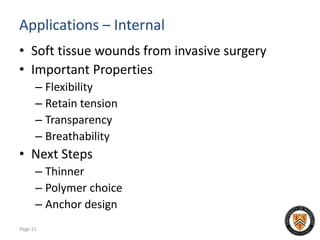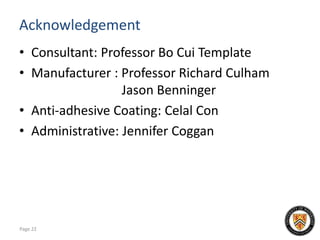Physical Adhesive Patch for Wound Protection
- 2. Introduction • Market for wound management product is increasing • Develop alternative of chemical adhesive bandage – “The quickest and easiest medical aid in any circumstance” • Physical adhesion patch – uses swelling nature of the micro-needles to physically hold an open wound or a cut on the skin and internal organs “Bring surgical treatment to home” Page 2
- 3. Overview Page 3 • Overview commercial bandage • Physical adhesive patch • Future direction
- 4. Business Market for bandage Page 4 • Market age: 94 years • Wound management product increasing • Wound closures will remain the largest selling group of wound management products Johnson & Johnson. (2014, March. 20). Annual Report 2013, [Online]. Available: http://www.jnj.com/
- 5. Strength of chemical adhesion Page 5 Texture Technologies Corp. (2014, March. 20). TA.XT2 Texture Application Study: Adhesive Bandages [Online]. Available: http://128.121.92.221/adhesives_applications.html
- 6. Limitations of chemical adhesion • Skin irritant – Allergies by glues used for adhesives (contact dermatitis) – Damp skin underneath the patch – Sticky residues • Durability issue – Does not retain much tension on the skin required for a scar-free healing – Contact with water compromises the performance of adhesives Page 6
- 7. What we want to achieve • Primary goal – create functional prototype • Adhesion, tension retention and durability • Secondary goal – Extend prototype to different application • Internal and External • Under water • Tertiary goal – Commercialization Page 7
- 8. Overview Page 8 • Overview commercial bandage • Physical adhesive patch • Future direction
- 9. Theoretical design* Page 9 S. Y. Yang et al., “A bio-inspired swellable microneedle adhesive for mechanical interlocking with tissue”, Nature COMMUNICATIONS, Vol. 4, No. 1702, 2013
- 10. Design considerations Page 10 Patch • Size • Thickness Anchor design • Shape • Orientation Materials • Compatibility (fabrication) • Biocompatibility • Swell ability Synthesis • Small scale • Reproducibility
- 13. Materials (structural layer) Page 13 Poly- etheretherketone Polyetherimide Polycarbonate Polystyrene Young's modulus (GPa) 3.6 2.9–3.04 2.0–2.4 3.0–3.6 Tensile strength (MPa) 90–100 92–101 55–75 46–60 Glass transition temperature 143 °C 217 °C 147 °C 100 °C O2 permeation (x10-13.cm3.cm.cm- 2.s-1.Pa-1) 0.06-0.1 0.01 1.05 2
- 14. Materials (swellable layer) Page 14 Poly acrylic acid Polyacrylamide Polyvinyl alcohol Glass transition temperature 70 °C 165 °C 85 °C Price per 5g $40-49 $88.90 $9.06* Costs from Sigmal Aldrich *Value derived from $45.30 per 25g
- 15. Synthesis Methods Page 15 Micro-milling 3D printing Lithography Pros -accurate feature size -Low mold cost (Al) -Gas escape holes -strong and effective mold -precise shape(design) -cheap -short process time -wide range of feature size -smooth and sharp features Cons -high possibility of fracturing the drill tip -limitation of feature shape( no cone shape) -rough features on the sides of the molded material -run time too long -feature size range is too large -Material used for 3D printing not suitable for our prototype material -micro-scale hard to achieve -expensive -limitation in feature depth (700um depth not achievable) - feature ratio not suitable for our design
- 16. Prototype Page 16 • Pencil shaped anchors • Square orientation • Polystyrene • Hotpressed with aluminum template • Cylindrical shaped anchors • Square orientation • HDPE + LDPE • Hot-pressed with aluminum template treated with Silane
- 17. Overview Page 17 • Overview commercial bandage • Physical adhesive patch • Future direction
- 18. Further developments • Reduce thickness of the patch • Explore more polymers using same manufacturing technique • Scale up coverage area • Increase surface area – Shorter + smaller diameter anchors, more dense Page 18
- 19. Commercialization effort • Customizability – Cut patch into desired shapes – Remove anchors at undesirable locations • Pain management – Apply pain-relief additive – Consider the exit wound – Develop puncture & release mechanisms • Wound healing additives Page 19
- 20. Applications – External • Large surface area, shallow wounds • Important Properties – Flexibility – Retain tension – Biodegradability • Next Steps – Polymer choice – Anchor design Page 20
- 21. Applications – Internal • Soft tissue wounds from invasive surgery • Important Properties – Flexibility – Retain tension – Transparency – Breathability • Next Steps – Thinner – Polymer choice – Anchor design Page 21
- 22. Acknowledgement • Consultant: Professor Bo Cui Template • Manufacturer : Professor Richard Culham Jason Benninger • Anti-adhesive Coating: Celal Con • Administrative: Jennifer Coggan Page 22
Editor's Notes
- #5: We’re the fastest-growing top 10 Pharmaceutical Company in the United States, Europe and Japan and recorded 15 consecutive quarters of operational sales growth in this segment. S. Y. Yang et al., “A bio-inspired swellable microneedle adhesive for mechanical interlocking with tissue”, Nature COMMUNICATIONS, Vol. 4, No. 1702, 2013
- #6: http://128.121.92.221/adhesives_applications.html
- #7: http://allergies.about.com/od/contactdermatitis/a/Allergy-To-Bandages-And-Adhesives.htm
- #10: Johnson & Johnson (2013).
- #14: HJ
- #15: Hj
- #20: Hj



![Business Market for bandage
Page 4
• Market age: 94 years
• Wound management
product increasing
• Wound closures will remain
the largest selling group of
wound management
products
Johnson & Johnson. (2014, March. 20). Annual Report 2013, [Online]. Available:
http://www.jnj.com/](https://image.slidesharecdn.com/7d8da069-f1b6-4055-8bc0-beb9227c91f8-150316154035-conversion-gate01/85/Physical-Adhesive-Patch-for-Wound-Protection-4-320.jpg)
![Strength of chemical adhesion
Page 5 Texture Technologies Corp. (2014, March. 20). TA.XT2 Texture Application Study: Adhesive
Bandages [Online]. Available: http://128.121.92.221/adhesives_applications.html](https://image.slidesharecdn.com/7d8da069-f1b6-4055-8bc0-beb9227c91f8-150316154035-conversion-gate01/85/Physical-Adhesive-Patch-for-Wound-Protection-5-320.jpg)

















